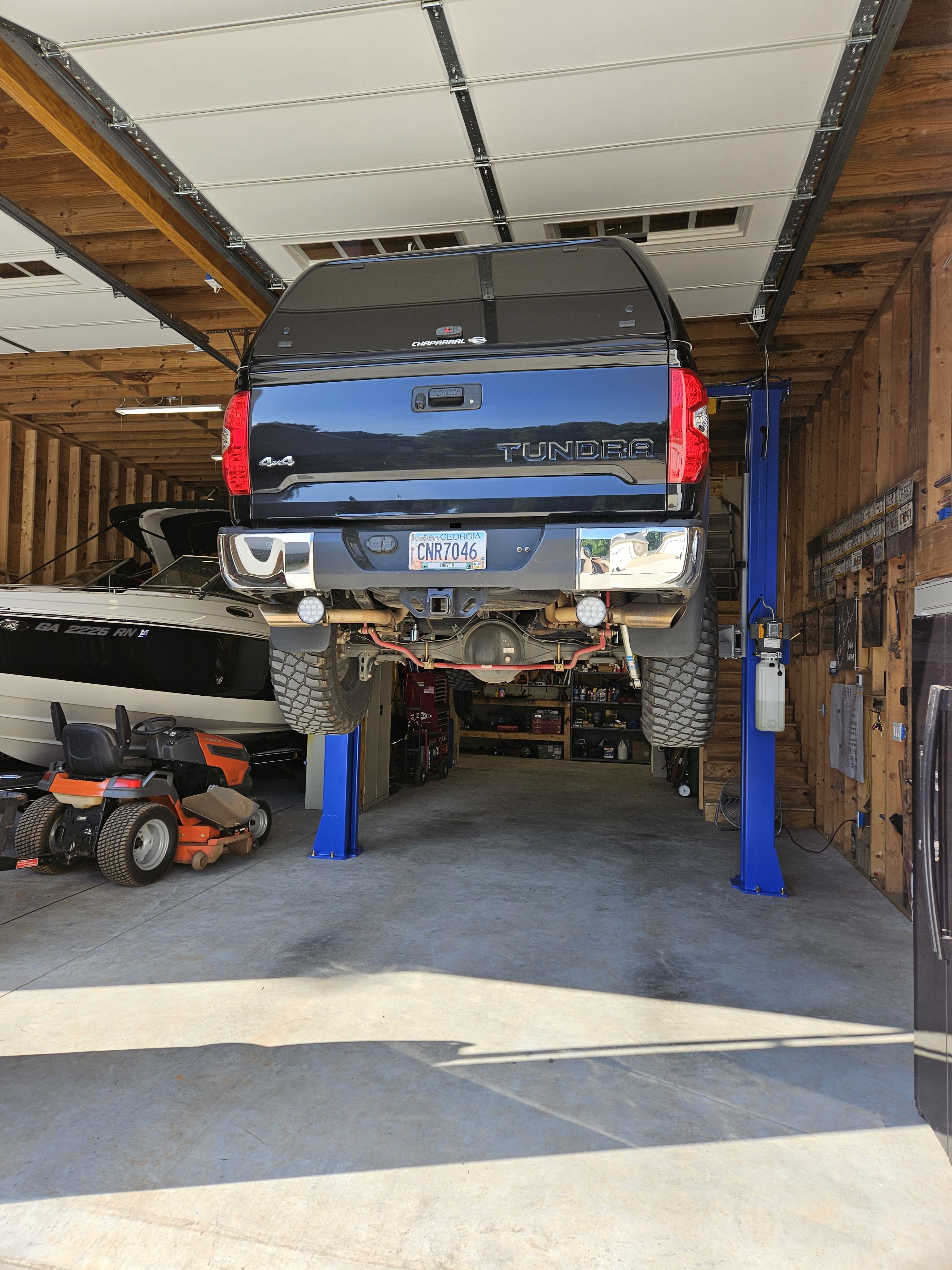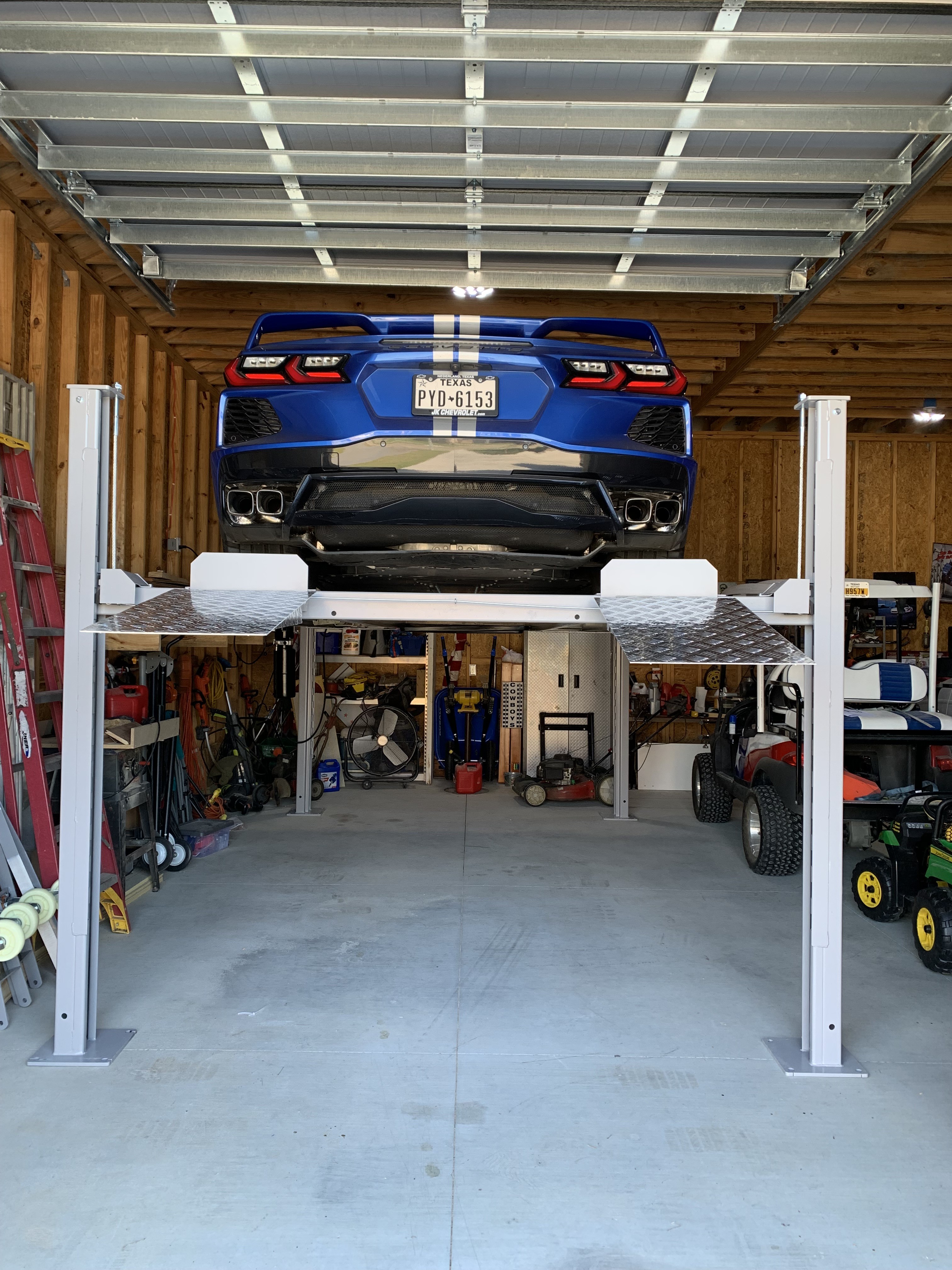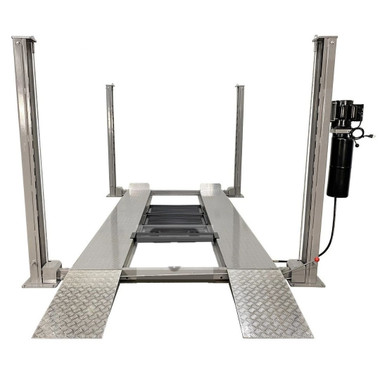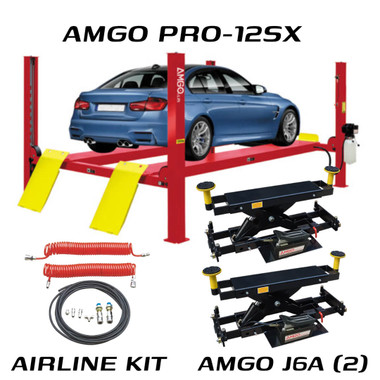The Benefits of Investing in a Car Lift for Your Garage
Estimated 0 min read
For passionate car enthusiasts and practical multi-car households alike, the decision to install a car lift in a garage can lead to a significant enhancement of space and function. Leading companies like American Custom Lifts, serving for over two decades, have designed their range of vehicle lifting systems to not just address common parking and storage issues, but to also profoundly transform how a garage serves its owner.
Installing a car lift is a strategic move that does more than free up square footage. It doubles as a poised platform that not only liberates parking space – accommodating not just the family sedan but precious collectible models as well – but also bolsters security against theft and vandalism, all while safeguarding your vehicle from the whims of weather.
It's not solely about parking; the addition of a garage lift facilitates meticulous vehicle maintenance. Raising your vehicle above ground offers remarkable ease of access for inspections and repairs, particularly to the undercarriage. Furthermore, optimizing garage lifts for storage begets a ripple effect allowing for the orderly arrangement of tools, bicycles, and much more, culminating in a garage that's as organized as it is expansive.
Though vehicle lifting systems do entail an initial outlay and necessitate routine upkeep, the tangible payoff in convenience and maintained vehicle integrity positions the investment in brands such as American Custom Lifts not as a mere luxury, but as a judicious choice for long-term gains.
Statistics underscore the practicality behind the investment: lifts like those from American Custom Lifts not only double a garage’s parking capacity but support hefty weights safely, up to 3 tons for scissor lifts and an impressive 5 tons for robust 4-column options. With varying lifespans that stretch into many years, these lifts are less a purchase and more a commitment toward efficiency, safety, and the sustained appeal of your vehicles. Evidently, despite upfront costs, the convergence of convenience, aesthetics, and practicality that car lifts introduce make them an increasingly popular feature in modern residential garages and workshops.
Maximizing Space with a Car Lift
Integrating automotive lifts into your home garage is not only a practical solution for car lift storage but also an efficient method to maximize space. Particularly, a car lift dramatically increases parking capacity, a boon for households with multiple vehicles or growing collections. Whether you opt for vehicle lifts like four-post lifts designed for heavier cars or adaptive two-post lifts, the advantages remain significant.
By employing automotive lifts, the utilization of vertical space transforms your garage, allowing for dual-layered parking systems. This setup can effectively double your parking area without the need for expanding the existing garage footprint, perfect for urban homes with limited space. In addition to space savings, vehicle lifts facilitate easier maintenance and inspection of your vehicles, enhancing daily usability and access.
Our findings from North American Auto Equipment reveal a broad selection of automotive lifts suitable for different technical and spatial configurations. For instance, options range from in-ground scissor lifts, ideal for low-ceiling garages, to portable single-post lifts that offer versatility and easy maneuverability within various sections of a garage. Each type of lift accommodates distinct vehicle dimensions and weights, ensuring that every homeowner finds the right fit for their specific needs.
Understanding the dimensions and installation requirements is crucial. For example, maintaining adequate distance between the lift, vehicle, and garage walls is necessary for safe operation and ease of movement. Also, the right ceiling height, typically no less than 12 feet, is essential to accommodate lifts and allow comfortable workspace underneath raised vehicles. Lastly, incorporating automotive lifts might necessitate modifications in garage infrastructure like floor reinforcement and electrical setups to support the lift system.
Thus, a well-chosen vehicle lift not only maximizes car storage but also enhances the functionality of your garage, making it a multipurpose area that extends beyond simple vehicle storage to a valuable workspace for vehicle care and maintenance.

Protecting Your Vehicle Investments
Installing a car lift in your garage is not just a matter of convenience; it's a strategic choice for vehicle protection. A staggering 81% of homeowners suffering from limited parking space have turned to car lifts to solve their problems. By elevating vehicles off the ground, you can avoid vehicle deterioration and damage from environmental factors, reducing the likelihood of needing frequent car repair machinery.
Statistics show that vehicles parked indoors are 64% less likely to be vandalized or stolen. Furthermore, cars housed in garages are 33% less likely to require body repairs, a testament to the protective environment a garage can provide. Utilizing a car lift makes this possible without sacrificing additional space, thereby enhancing the safety and longevity of your vehicle investments.
Storing your high-value vehicles like a Mercedes on a car lift also avoids the cumbersome task of snow and ice removal during the colder months. This not only saves time but also prevents potential damage from harsh weather conditions. The average vehicle owner can save between $500 to $1000 in annual off-site storage fees by using car lifts for seasonal storage.
To ensure the continued efficacy and safety of your car lift, annual inspections by qualified lift inspectors recommended by ANSI are crucial. Adhering to these guidelines and insisting on OE replacement parts during any necessary repairs ensures your car lift maintains its functionality and safety, protecting your vehicle investments effectively.
By integrating these advanced solutions, car owners can not only safeguard their investment but also enhance their experience of ownership, knowing their automotive assets are secure, preserved, and ready when needed.
Maintaining Your Vehicle with Ease
For those who dedicate themselves to car maintenance, the utilization of a car lift can dramatically alter the ease and safety with which maintenance tasks can be performed. Specifically, the auto repair equipment like Challenger 2-post lifts, are instrumental in lifting vehicles to a comfortable height. This allows for effortless access to the undercarriage for tasks such as brake changes or transmission checks, without the discomfort or hazard of cramped spaces or lying on the back.
Car lifts also cater to different maintenance and storage needs. Light-duty models of Challenger 2-post lifts, with lifting capacities ranging from 7,000 to 10,000 lbs, are suited perfectly for most types of passenger cars and light trucks. For larger vehicles like full-size trucks and vans, heavy-duty models offer capacities that begin at 11,000 lbs and can exceed 18,000 lbs. These variations ensure that any vehicle, regardless of size, can be accommodated efficiently and safely.
Moreover, the integration of safety features such as automatic arm restraints, dual-point lock releases, and overhead safety shut-offs, which are standard in Challenger lifts, guarantees that operation remains safe for both the mechanic and the vehicle. Advanced features in some models, including digital lifting height displays and integrated weight gauges, add a layer of precision crucial for effective car maintenance, ensuring that every repair or check is done accurately.
To ensure longevity and optimal performance of this auto repair equipment, regular maintenance of the car lifts themselves is crucial. This involves routine checks and replacements such as the hydraulic oil, which should be replaced considering the viscosity requirements adjusted for seasonal changes. Similarly, keeping the hydraulic system free from solid impurities by using only filtered, clean hydraulic oil during refueling, and ensuring cleanliness in maintenance processes, preserves the functionality and safety of the lifts.
In conclusion, integrating a car lift into your garage or service area not only streamlines vehicle maintenance but enhances safety and efficiency, making it an indispensable component of modern auto repair equipment.

The Financial Implications of Car Lift Installation
When considering the addition of a car lift in your garage, understanding the initial investment and potential cost savings is crucial. The average cost for a standard two-post car lift with a 9K lb. capacity is approximately $2,700, while a more robust four-post lift can run around $4,500. Installation fees typically add about $1,000, varying slightly based on the complexity of the lift system and garage specifications.
eyond the purchase and installation, additional modifications such as high-lift kits for garage doors or anchoring the lift to the garage floor are necessary, costing around $900 and $350, respectively. These enhancements ensure the functionality and safety of your car lift, contributing to the overall financial layout.
However, these costs should be weighed against the potential cost savings offered by owning a car lift. By enabling at-home vehicle maintenance and storage, car lifts eliminate the ongoing expenses of professional services and off-site storage fees. Over time, this can result in significant financial advantages, justifying the initial investment. Moreover, the convenience of managing vehicle maintenance in your own space cannot be underestimated, adding intrinsic value beyond mere dollars and cents.
In conclusion, while the initial investment in a car lift may be substantial, the long-term cost savings and enhanced personal convenience make it a financially sound choice for many car enthusiasts and homeowners. Always consider both the upfront costs and potential savings when planning your garage upgrades.
Types of Car Lifts and Their Unique Features
Car lifts are essential tools in the automotive industry, serving various roles from vehicle repair to storage optimization. The choice of car lift largely depends on the specific needs of the user, encompassing elements such as space availability, vehicle type, and budgetary considerations. Among the most popular lifts are two-post hoists, four-post hoists, and scissor hoists, each offering unique benefits and features.
Two-post hoists are favored in both residential and commercial settings for their space-saving design, making them ideal for smaller garages or shops. These lifts use two hydraulic posts with four lifting arms to securely hoist vehicles for undercarriage access, making them perfect for routine maintenance tasks such as tire changes and oil changes. Interestingly, statistics show that two-post lifts are the most common choice for automotive shops, with asymmetrical lifts designed to avoid contact with vehicle doors.
Four-post hoists are known for their stability and high weight capacities, able to support heavier vehicles like trucks and large SUVs. These lifts feature a drive-on platform that simplifies the process of positioning the vehicle, a preferred choice in busy professional environments. They typically range in lifting capabilities from 6,000 to 40,000 pounds. Due to their robust design, four-post lifts are generally more expensive and consume more space than two-post models. Current market offers by brands like JMC include substantial discounts on these lifts, enhancing affordability for business owners.
Scissor hoists, on the other hand, offer a compact and mobile solution, ideal for garages with limited space. These hoists can be categorized into low, mid, and full-rise models, with the full-rise scissor lifts capable of raising vehicles significantly high off the ground for complete undercarriage access. While scissor hoists are portable and versatile, they generally have lower lifting capacities compared to their two-post and four-post counterparts.
Choosing the right type of car lift involves assessing the specific requirements of a garage or automotive service center. Factors such as available space, the weight of vehicles to be lifted, and the type of service tasks performed are crucial in determining whether a two-post hoist, four-post hoist, or scissor hoist is the most suitable option. By matching a lift's capabilities with these demands, auto shop owners and home garage users can maximize both efficiency and safety.
Ensuring a Durable Investment: Car Lift Longevity
The key to maximizing car lift longevity is to commit to consistent maintenance of vehicle lifts. Leading manufacturers like American Custom Lifts design car lifts that promise durability, but this is contingent on proper management and care. For instance, the difference between a car lift that lasts 5 years versus one that serves you for a decade often boils down to adherence to regular maintenance schedules.
Maintenance is a broad term that encompasses a variety of essential practices. Regular inspections are crucial to detect any signs of wear and tear or mechanical issues that could escalate into serious problems. This includes examining hydraulic systems, ensuring all moving parts are well-lubricated, and checking that all bolts and cables are tightly secured. Such actions not only ensure the safety of the operations but also significantly enhance the car lift longevity.
Moreover, understanding the type of lift and its intended usage plays a crucial role in its maintenance. For instance, Two-Post lifts, which are suitable for most repair jobs, might require different maintenance practices compared to Four-Post lifts that are generally used for long-term storage. Regardless of the type, all lifts benefit from regular cleaning to prevent dirt, debris, and corrosive substances from impairing their function and shortening their lifespan.
Implementing these maintenance practices helps in avoiding the overloading of the vehicle lift, which is a common issue that can significantly reduce its lifespan. Regular maintenance not only supports optimal performance but also maximizes the return on investment by extending the car lift's operational life.
Installation Process for Garage Car Lifts
The process of car lift installation, especially involving vehicle lifting systems, is a meticulous approach that demands detailed planning and adherence to safety protocols. Initially, the potential car lift site must be assessed to ensure it meets required standards such as ceiling height, overall space dimensions, and absence of obstructions. Critical to a safe and efficient installation is the verification of a clean, level floor that supports the car lift's stability.
Following site preparation, the assembly of the car lift should align with the manufacturer’s instructions meticulously. For instance, floor anchoring, a vital step for safety, should adhere to specified torque settings—approximately 85 ft-lbs, ensuring the equipment is securely fastened to the ground. Notably, the concrete depth for the anchoring columns should range between 6 to 12 inches with a minimum 3000 PSI to provide a robust foundation.
Configurations vary between different types of car lifts, such as the commonly used 2 post and 4 post lifts. Understanding the specifics of your chosen model, such as asymmetric loading (typically a 30/70 split) and symmetric loading (usually a 50/50 split), can dictate how much space is required around the vehicle once mounted. Additionally, it is advantageous for commercial setups to install the power unit column on the passenger side to enhance the efficiency of vehicle lifting systems.
Once installed, rigorous testing of the hoist is recommended. This includes bleeding the air out of hydraulic systems on direct drive lifts and ensuring proper synchronization of cables. These steps are essential to confirm that the car lift operates smoothly and maintains balanced lifting. Continuous monitoring and regular inspections are integral post-installation steps to ensure enduring safety and functionality, aligning with ALI lift standards or manufacturers' guidelines.
Ultimately, professional guidance or hiring a certified installer can provide assurance that the car lift installation process adheres strictly to safety standards, ensuring optimal operation within your garage setup. For any further assistance, help is available at the contact specified for installer support.
Improving Access and Efficiency: The Mechanic's Perspective
In professional automotive shops, speed and efficiency are critical components in meeting the ever-increasing demands of vehicle maintenance and repair. For instance, mechanics at Volvo Trucks can change a set of brakes 45 minutes faster using an inground lift compared to traditional methods. Such lifts, be it 2-post or 4-post models from industry leaders like Triumph car lifts, Amgo car lifts, and Atlas lifts, have revolutionized how mechanics operate, providing improved access to all parts of the vehicle—this allows for a more effective troubleshooting process.
The choice between 2-post and 4-post automotive lifts hinges on several factors like design, space requirements, stability, and load capacity. While 2-post lifts are known for their space-saving design and ease of installation, 4-post lifts are lauded for their exceptional stability and capacity, making them a safer option for both the mechanics and the vehicles. They adapt well to various vehicle types and weight limits, which is crucial as the complexity of vehicles continues to grow. AMGO Car lifts, for example, can be customized with multiple lifting rams, each capable of handling significant weight, thereby catering to specialized workshop needs.
4-post lifts maximize operational efficiency and space utilization, potentially doubling a garage's capacity by levering vertical storage. The durability of products from Triumph car lifts, Amgo car lifts, and Atlas lifts ensures they stand up to daily use, providing a solid return on investment. The addition of a 4-post lift not only enhances safety standards but also increases customer satisfaction and trust, which can have a direct positive impact on revenue. Whether you're a professional mechanic or a DIY enthusiast, the ease of access and comprehensive vehicle support offered by these lifts transform maintenance processes, optimizing productivity and elevating service quality.











